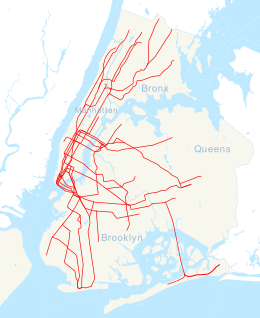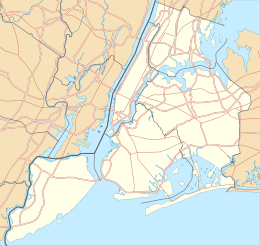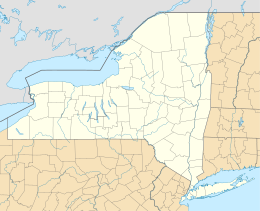railroad.wikisort.org - Station
The 103rd Street station is a local station on the IRT Lexington Avenue Line of the New York City Subway. Located at the intersection of Lexington Avenue and 103rd Street in East Harlem, it is served by the 6 train at all times, the <6> train during weekdays in the peak direction, and the 4 train during late nights.
103 Street | ||||||||||||||||||||||||||||||||||||||||||||||||||||||||||||||||||||
|---|---|---|---|---|---|---|---|---|---|---|---|---|---|---|---|---|---|---|---|---|---|---|---|---|---|---|---|---|---|---|---|---|---|---|---|---|---|---|---|---|---|---|---|---|---|---|---|---|---|---|---|---|---|---|---|---|---|---|---|---|---|---|---|---|---|---|---|---|
 | ||||||||||||||||||||||||||||||||||||||||||||||||||||||||||||||||||||
| Station statistics | ||||||||||||||||||||||||||||||||||||||||||||||||||||||||||||||||||||
| Address | East 103rd Street & Lexington Avenue New York, NY 10029[1] | |||||||||||||||||||||||||||||||||||||||||||||||||||||||||||||||||||
| Borough | Manhattan | |||||||||||||||||||||||||||||||||||||||||||||||||||||||||||||||||||
| Locale | East Harlem | |||||||||||||||||||||||||||||||||||||||||||||||||||||||||||||||||||
| Coordinates | 40.79029°N 73.947687°W | |||||||||||||||||||||||||||||||||||||||||||||||||||||||||||||||||||
| Division | A (IRT)[2] | |||||||||||||||||||||||||||||||||||||||||||||||||||||||||||||||||||
| Line | IRT Lexington Avenue Line | |||||||||||||||||||||||||||||||||||||||||||||||||||||||||||||||||||
| Services | 4 6 | |||||||||||||||||||||||||||||||||||||||||||||||||||||||||||||||||||
| Transit | ||||||||||||||||||||||||||||||||||||||||||||||||||||||||||||||||||||
| Structure | Underground | |||||||||||||||||||||||||||||||||||||||||||||||||||||||||||||||||||
| Platforms | 2 side platforms | |||||||||||||||||||||||||||||||||||||||||||||||||||||||||||||||||||
| Tracks | 4 | |||||||||||||||||||||||||||||||||||||||||||||||||||||||||||||||||||
| Other information | ||||||||||||||||||||||||||||||||||||||||||||||||||||||||||||||||||||
| Opened | July 17, 1918[4] | |||||||||||||||||||||||||||||||||||||||||||||||||||||||||||||||||||
| Opposite- direction transfer | Yes | |||||||||||||||||||||||||||||||||||||||||||||||||||||||||||||||||||
| Traffic | ||||||||||||||||||||||||||||||||||||||||||||||||||||||||||||||||||||
| 2019 | 4,039,570[5] | |||||||||||||||||||||||||||||||||||||||||||||||||||||||||||||||||||
| Rank | 120 out of 424[5] | |||||||||||||||||||||||||||||||||||||||||||||||||||||||||||||||||||
| ||||||||||||||||||||||||||||||||||||||||||||||||||||||||||||||||||||
| ||||||||||||||||||||||||||||||||||||||||||||||||||||||||||||||||||||
| ||||||||||||||||||||||||||||||||||||||||||||||||||||||||||||||||||||
| ||||||||||||||||||||||||||||||||||||||||||||||||||||||||||||||||||||
| ||||||||||||||||||||||||||||||||||||||||||||||||||||||||||||||||||||
This station was constructed as part of the Dual Contracts by the Interborough Rapid Transit Company and opened in 1918. It was renovated in 1990 and in 2015-2016.
History
Construction and opening
Following the completion of the original subway, there were plans to construct a line along Manhattan's east side north of 42nd Street. The original plan for what became the extension north of 42nd Street was to continue it south through Irving Place and into what is now the BMT Broadway Line at Ninth Street and Broadway. In July 1911, the IRT had withdrawn from the talks, and the Brooklyn Rapid Transit Company (BRT) was to operate on Lexington Avenue. The IRT submitted an offer for what became its portion of the Dual Contracts on February 27, 1912.[6][7]
In 1913, as part of the Dual Contracts, which were signed on March 19, 1913,[8] the Public Service Commission planned to split the original Interborough Rapid Transit Company (IRT) system from looking like a "Z" system (as seen on a map) to an "H"-shaped system. The original system would be split into three segments: two north–south lines, carrying through trains over the Lexington Avenue and Broadway–Seventh Avenue Lines, and a west–east shuttle under 42nd Street. This would form a roughly "H"-shaped system.[9][10] It was predicted that the subway extension would lead to the growth of the Upper East Side and the Bronx.[11][12]
103rd Street station opened on July 17, 1918, with service initially running between Grand Central–42nd Street station and 167th Street via the line's local tracks.[4] On August 1, the "H system" was put into place, with through service beginning on the new east and west side trunk lines, and the institution of the 42nd Street Shuttle along the old connection between the sides.[13] The cost of the extension from Grand Central was $58 million.[14]
Later years
The city government took over the IRT's operations on June 12, 1940.[15][16] This station was renovated in 1990.
The Downtown platform was renovated in 2015, with the placement of new white wall tiles, new floor tiles and benches. From January 26, 2016, to May 23, 2016, the Uptown platform was closed for renovation and was done in the same style as the Downtown platform. This was completed about a month earlier than planned.[17]
Station layout
| G | Street level | Entrances/exits |
| P Platform level |
Side platform | |
| Northbound local | ← ← | |
| Northbound express | ← | |
| Southbound express | | |
| Southbound local | | |
| Side platform | ||

This underground station has four tracks and two side platforms. The two center express tracks are used by the 4 and 5 trains during daytime hours.[18] The 6 stops here at all times, and the 4 stops here during late nights.[19][20]
All other stations between Grand Central–42nd Street and 125th Street on the line, except 110th Street, have the local tracks on an upper level and express ones on the lower level, with emergency exits provided at local stations for emergency egress.[18]
Both platforms have their original trim line, which has "103" tablets on it at regular intervals, and name tablets, which read "103RD STREET" in the original mosaic. Prior to the 1990 station renovation, mosaic tiles were used so as to depict the 103rd Street mosaic as a sign hanging down from a horizontal support beam above. These "signholders" were covered over in 1990. An emergency phone is present immediately to the south of the southbound local platform.
The 1990 ceramic artwork here is called Neo-Boriken by Nitza Tufiño, based on the neighborhood's Caribbean and Latin American heritage. According to the accompanying plaque, P.R.O.M.I.S.E. (Puerto Rican Organization for Growth Research Education and Self Sufficiency) helped to fund the murals.[21] This is one of two projects Tufiño made for MTA Arts & Design; the other, Westside Views – a community project for which she was the lead artist – can be found at 86th Street.[22]
Exits
The station's only entrance/exit is a mezzanine above the platforms and tracks near the south end. It has two staircases from each platform, a waiting area that can be used as a crossover, turnstile bank, token booth, and two street stairs going up to the southeast and southwest corners of 103rd Street and Lexington Avenue.[23] The mezzanine has mosaics indicating uptown and downtown directions. The fences surrounding each exit stairway are unusual as each section of the fence is at a different elevation, as they are located on Duffy's Hill, a sharp incline, on Lexington Avenue between 102nd and 103rd Streets.
References
- "Borough of Manhattan, New York City". Government of New York City. Archived from the original on January 7, 2021. Retrieved December 28, 2020.
- "Glossary". Second Avenue Subway Supplemental Draft Environmental Impact Statement (SDEIS) (PDF). Vol. 1. Metropolitan Transportation Authority. March 4, 2003. pp. 1–2. Archived from the original (PDF) on February 26, 2021. Retrieved January 1, 2021.
- "Manhattan Bus Map" (PDF). Metropolitan Transportation Authority. July 2019. Retrieved December 1, 2020.
- "Lexington Av. Line to be Opened Today" (PDF). The New York Times. July 17, 1918. p. 13. ISSN 0362-4331. Archived (PDF) from the original on December 14, 2021. Retrieved April 21, 2020.
- "Facts and Figures: Annual Subway Ridership 2014–2019". Metropolitan Transportation Authority. 2020. Retrieved May 26, 2020.
- Walker, James Blaine (1918). Fifty Years of Rapid Transit — 1864 to 1917. New York, N.Y.: Law Printing. pp. 230–233. Retrieved November 6, 2016.
- "Petition for Subway in Lexington Ave". The New York Times. May 22, 1912. ISSN 0362-4331. Archived from the original on May 4, 2022. Retrieved February 16, 2009.
A petition is being circulated among the residents and property owners of the section just south of the Grand Central Station, in Park and Lexington Avenues, protesting against the proposed abandonment of the construction of the Subway in Lexington Avenue, between Forty-third and Thirty-second Streets.
- "Subway Contracts Solemnly Signed; Cheers at the Ceremonial Function When McCall Gets Willcox to Attest" (PDF). The New York Times. March 20, 1913. ISSN 0362-4331. Archived (PDF) from the original on May 4, 2022. Retrieved January 11, 2018.
- "Money Set Aside For New Subways; Board of Estimate Approves City Contracts to be Signed To-day with Interboro and B.R.T." (PDF). The New York Times. March 19, 1913. ISSN 0362-4331. Archived (PDF) from the original on July 7, 2021. Retrieved November 10, 2017.
- Engineering News-record. McGraw-Hill Publishing Company. 1916. p. 846. Archived from the original on May 4, 2022. Retrieved December 28, 2020.
- Whitney, Travis H. (March 10, 1918). "The Seventh and Lexington Avenue Subways Will Revive Dormant Sections — Change in Operation That Will Transform Original Four-Tracked Subway Into Two Four-Tracked Systems and Double Present Capacity of the Interborough". The New York Times. p. 12. Archived from the original on May 4, 2022. Retrieved August 26, 2016.
- "Public Service Commission Fixes July 15 For Opening of The New Seventh and Lexington Avenue Subway Lines — Will Afford Better Service and Less Crowding — Shuttle Service for Forty-Second Street — How the Various Lines of the Dual System Are Grouped for Operation and List of Stations on All Lines". The New York Times. May 19, 1918. p. 32. Archived from the original on May 4, 2022. Retrieved November 6, 2016.
- "Open New Subway Lines to Traffic; Called a Triumph — Great H System Put in Operation Marks an Era in Railroad Construction — No Hitch in the Plans — But Public Gropes Blindly to Find the Way in Maze of New Stations — Thousands Go Astray — Leaders in City's Life Hail Accomplishment of Great Task at Meeting at the Astor". The New York Times. August 2, 1918. p. 1. Archived from the original on January 6, 2021. Retrieved November 6, 2016.
- "Finish a New Link of the Dual Subway; Lexington Avenue Line North of Forty-second Street to Begin Local Service Wednesday. Branch Extends to Bronx Through service, with Times SquareGrand Central Shuttle Connections, to Open Soon. Changes in the Bronx". The New York Times. July 11, 1918. p. 20. ISSN 0362-4331. Archived from the original on May 4, 2022. Retrieved January 8, 2017.
- "City Transit Unity Is Now a Reality; Title to I.R.T. Lines Passes to Municipality, Ending 19-Year Campaign". The New York Times. June 13, 1940. ISSN 0362-4331. Archived from the original on January 7, 2022. Retrieved May 14, 2022.
- "Transit Unification Completed As City Takes Over I. R. T. Lines: Systems Come Under Single Control After Efforts Begun in 1921; Mayor Is Jubilant at City Hall Ceremony Recalling 1904 Celebration". New York Herald Tribune. June 13, 1940. p. 25. ProQuest 1248134780.
- "103rd Street - Full Service Restored - Planned Service Changes". mta.info. Metropolitan Transportation Authority. May 23, 2016. Archived from the original on February 11, 2019. Retrieved March 29, 2020.
- Dougherty, Peter (2006) [2002]. Tracks of the New York City Subway 2006 (3rd ed.). Dougherty. OCLC 49777633 – via Google Books.
- "4 Subway Timetable, Effective June 26, 2022". Metropolitan Transportation Authority. Retrieved August 1, 2022.
- "6 Subway Timetable, Effective December 19, 2021". Metropolitan Transportation Authority. Retrieved February 3, 2022.
- "103rd Street – Nitza Tufiño – Neo-Boriken, 1990". web.mta.info. Metropolitan Transportation Authority. Archived from the original on September 1, 2019. Retrieved March 30, 2020.
- "86th Street – Nitza Tufiño – Westside Views, 1989". web.mta.info. Metropolitan Transportation Authority. Archived from the original on August 19, 2020. Retrieved April 16, 2020.
- "103rd Street Neighborhood Map". mta.info. Metropolitan Transportation Authority. April 2018. Archived from the original on December 27, 2021. Retrieved December 28, 2020.
External links
- nycsubway.org – IRT East Side Line: 103rd Street
- nycsubway.org — Neo-Boriken Artwork by Nitza Tufino (1990)
- Station Reporter — 4 Train
- Station Reporter — 6 Train
- MTA's Arts For Transit — 103rd Street (IRT Lexington Avenue Line)
- 103rd Street entrance from Google Maps Street View
- Platforms from Google Maps Street View
На других языках
- [en] 103rd Street station (IRT Lexington Avenue Line)
[ru] 103-я улица (линия Лексингтон-авеню, Ай-ар-ти)
«103-я улица» (англ. 103rd Street) — станция Нью-Йоркского метрополитена, расположенная на линии Лексингтон-авеню, Ай-ар-ти. На станции останавливаются маршруты: 4 (ночью), 6 (круглосуточно) и <6> (в будни днём в пиковом направлении). Станцию проходят без остановки маршруты 4 (круглосуточно, кроме ночи) и 5 (круглосуточно, кроме ночи). Она представлена двумя боковыми платформами, обслуживающими два локальных пути.Другой контент может иметь иную лицензию. Перед использованием материалов сайта WikiSort.org внимательно изучите правила лицензирования конкретных элементов наполнения сайта.
WikiSort.org - проект по пересортировке и дополнению контента Википедии



